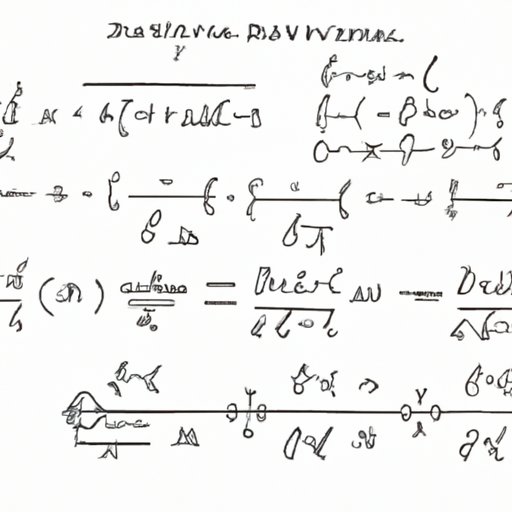I. Introduction
If you’ve ever taken calculus in high school or college, you’ve probably encountered derivatives at some point. But what exactly are they, and why are they important? In simple terms, a derivative is a measurement of how a function changes with respect to its input variable.
Derivatives have a variety of practical applications in fields such as science, engineering, and finance. They allow us to find maximum and minimum values of functions, calculate rates of change, and much more. In this article, we’ll cover everything you need to know to find derivatives, including step-by-step guides, practical applications, video tutorials, practice exercises, and a historical perspective.
II. Step-by-Step Guide
Before we dive into the details, let’s start with a basic explanation of what a derivative is. Put simply, the derivative of a function tells us how much the output of the function changes when the input changes by a small amount. For example, if we have a function f(x) = x^2, the derivative of f with respect to x (written as f'(x)) would be 2x.
Now that we have a basic understanding of derivatives, let’s move on to step-by-step guide for finding the derivative of a basic function:
- Identify the function and the input variable (usually x).
- Apply the power rule: if the function is of the form f(x) = x^n, the derivative is f'(x) = nx^(n-1).
- If the function is a sum or difference of basic functions, find the derivatives of each individual function and add or subtract them as appropriate.
- If the function is a product or quotient of basic functions, use the product rule or quotient rule to find the derivative. (See section II.C for more information on these rules.)
Now that we’ve covered the basics, let’s move on to more complex functions. Finding derivatives for more complex functions can be a bit more challenging, but the basic principles still apply. Here are a few tips to keep in mind:
- Break the function down into smaller parts and find the derivative of each part individually.
- Use the chain rule to find the derivative of composite functions (functions inside of functions).
- Use the product rule or quotient rule as needed.
III. Practical Applications
Derivatives have a wide range of practical applications in fields such as science, engineering, and finance. Here are just a few examples:
- Physics: Derivatives are used to calculate rates of change, such as velocity and acceleration. They are also used to find maximum and minimum values of functions, such as the maximum height of a projectile or the minimum energy required to launch a rocket.
- Engineering: Derivatives are used in designing roller coasters, determining the ideal shape of airplane wings, and much more.
- Finance: Derivatives are used to calculate investment returns, evaluate risk, and develop financial models.
Understanding derivatives can help you solve problems more effectively in these fields and many others.
IV. Video Tutorial
Some people find it easier to learn through visual aids, so we’ve included a video tutorial demonstrating how to find the derivative of a basic function:
And here is a breakdown of the steps illustrated in the video:
- Identify the function and the input variable (usually x).
- Apply the power rule: if the function is of the form f(x) = x^n, the derivative is f'(x) = nx^(n-1).
- If the function is a sum or difference of basic functions, find the derivatives of each individual function and add or subtract them as appropriate.
V. Practice Exercises
Of course, practice is key to truly understanding derivatives. Here are a few practice exercises for you to try:
- Find the derivative of f(x) = x^3.
- Find the derivative of f(x) = sin(x) + cos(x).
- Find the derivative of f(x) = (2x^2 + 3x – 4)/(x^2 – 1).
And here are the answers:
- f'(x) = 3x^2
- f'(x) = cos(x) – sin(x)
- f'(x) = (6x^3 + 5x – 6)/(x^2 – 1)^2
VI. Historical Perspective
Finally, let’s take a step back and look at the history of the derivative. The concept of the derivative dates back to the ancient Greeks, who were fascinated by the idea of calculating rates of change. However, it wasn’t until the 17th century that the derivative was truly developed as a mathematical concept.
Mathematicians such as Isaac Newton and Gottfried Leibniz made significant contributions to the development of calculus and the concept of the derivative. Today, understanding the history of the derivative can offer insight into the field of mathematics and its evolution over time.
VII. Conclusion
We hope this comprehensive guide has given you a better understanding of how to find derivatives, their practical applications, a helpful video tutorial, practice exercises, and even a brief history lesson.
